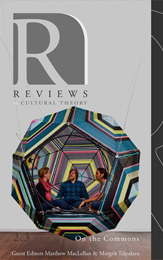from: Tess Takahashi
to: BRiC participants
date: Sat, May 14, 2011 at 12:14 PM
subject: Walking, Flocking, Constraints, Spontaneity – today at 2pm
Because it was fun last time, we’re doing it again.
Walking, flocking, three-ing, etc.
For any and all who’d like to explore some aspects of group relations + cooperation through structured play.
No experience necessary.
Wear whatever you like.
Small children welcome!
Saturday at 2pm til about 3pm in Lazlo Funtek 222.
It would be good if you showed up on time, but feel free to leave whenever you like.
Follow the signs from Lloyd lobby to Theatre building – just up the path and into the first building you come to.
1. Coming Together
Begin with an offer, an invitation to play. A space, a time, and (at least) two bodies willing.
In our time at Banff, we engaged in two kinds of movement projects related to the idea of “being in common.” First, we met one-on-one every other day or so to explore aspects of contact improvisation as a mode of negotiating relationship in one of the large dance studios. There we investigated questions of preparation, process, form, balance, experimentation, and collaboration between two people.
Second, we held four workshops during the residency that explored aspects of ensemble improvisation with varying groups of ten or so people from our research seminar.[1] In these, we led the group jointly, alternately giving direction. However, many of the exercises invited individuals from the group to take leadership at various points, posing new possibilities for movement for the rest of the group. Regardless of who was “leading,” these exercises required that those involved pay attention to each other, to actively watch how others in the room were moving in relation.
We were interested in how this playful movement work could illuminate our ways of being together in a seminar, a place where we as academics and thinkers talked with one another in a group context. We often started our sessions with a flocking exercise, which required individuals to move in a V-shaped formation like a flock of migrating birds.[2] The person at the head of the flock dictated the direction, pace, and quality of movement; the challenge for those following was to mimic the leader precisely and to move seamlessly as one body. However, leadership could shift with a simple turn. This flexibility required that participants pay attention to the rhythms of others in the group, for a sudden change in direction meant that the rest of the flock needed to take note and fall into place in order to avoid collision. This possibility suggested the dangers and demands inherent in conformity. We pointed out that, despite the “rules,” participants need not follow the lead of others. The group could split in two and the two groups could continue to move in relation to one another, albeit using different patterns of movement. An individual could break off on her own, but might not be followed if others were more interested in something else. The groups could, and often did, join back into one. These patterns played out within the rhythms of discussion within the seminar, as well as within the space of the studio. Individuals often, but not always, behaved very similarly in both settings, whether in the flow of language or in the flow of physical movement.
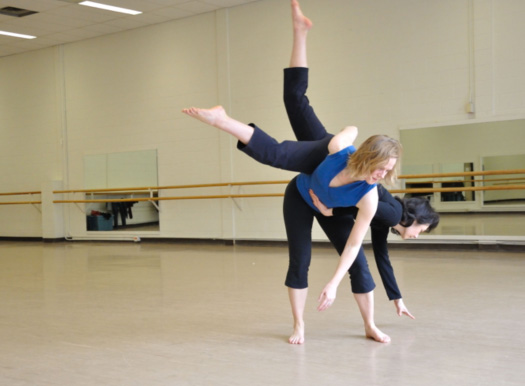
2. The Commons as the Formation of Movement
The game: how to move two different bodies in the same direction or, rather, how to move together in tension within the limits of difference?
This is not merely a physical question, although much can be learned from the work of musculature and bone against the force of weight and gravity. The body has an intelligence that grounds and transposes the challenges of coming together socially, ideologically, affectively. . . Like musical notes modulated into a different key, or the mutation of genes into something different, what can be revealed by the puzzle of two (or more) bodies in motion together in space and time?[3]
For us, the term “movement” has a number of resonances. It can describe not only physical movement, but also the kind of political movement that the idea of being in common connotes. To be “moved” is also to be moved emotionally, and suggests the kind of affective politics both Lauren Berlant and Michael Hardt explored during the residency seminars on being in common. At one point, Berlant used the term “rhythm” to describe the affective and political experience of the movement of the historical present. One exercise, led by visiting artist Pedro Reyes, made us think of the influence one person can have on the momentum of a larger movement. This game explored the physical influence that the rhythm of laughter could have on a group of people. It began with everyone lying down on the floor, resting his or her head on another person’s stomach, at the same time feeling the weight of another on his or her own abdomen. The laughter began in an artificial way, with people saying “ha ha ha ha ha…” However, bellies soon jostled heads in waves that ebbed and flowed across the group. Voices became harmonic and fluid, individual voices absorbed within a larger flow of sound or standing out in counterpoint. At other moments, the laughter died out almost completely, only to be revived by giggle somewhere at the periphery that sent waves of laughter rolling through our bodies once again.
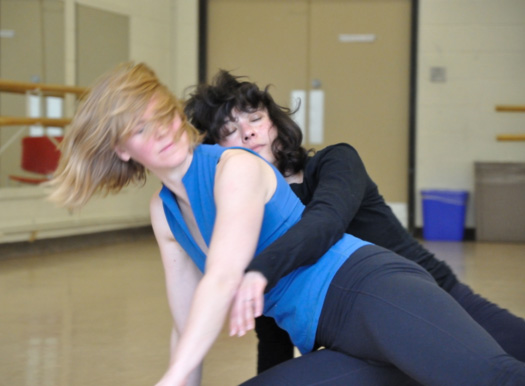
Transposing is a gesture neither of metaphorical assimilation nor of metonymic association. It is a style, in the sense of a form of conceptual creativity, like a sliding door, a choreographed slippage, a drifting away that follows a trajectory which can be traced a posteriori and thus be made accountable. Like a weather map, genetic printing or digital tracking, an account can be made of what will have been—in the first instance—a fluid flowing of becoming. (Braidotti 2006: 9)
3. The Transposition of Momentum to Belonging
Imagine this game of the commons as not only social or political exercise—the formation of a movement—but also as gravitational, centripetal force suspended across the extension of multiple limbs or as an assemblage of masses and velocities spiraling over the back body.
What does it mean to bear another’s weight? What does it mean to give one’s own? What would it mean to share the force of gravity at the point of balance? Whose force does this momentum, this movement then become?
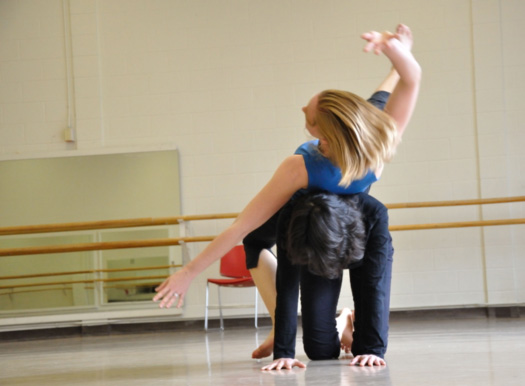
4. Becoming-Common at the Point of Contact
Notice the intimacy of joints where the touch of two intentionalities (each equal to their need) opens the space between and upon which hinges their mutual work. Neither is one’s force subsumed by the other nor is another’s desire barred by bodily coercion. Momentum dictates how bodies balance, where they join, but that balance is never fixed.
Contact—and what is common—shifts, flows and moves through the course of events.
Being in common requires the work of give and take between desire and compliance, freedom and constraint. Another group exercise required that five individuals move between motion and stillness in relation to one another, as the rest of the group watched. This exercise balanced the “freedom” to move anywhere in the performance space and in any way, with some very specific constraints. Namely, only two OR three of the five people could be moving within the space at any given time. The others needed to remain still until another had stopped, thus opening space for a new person to move. This meant that each person had to watch the rest of the group closely in order to make sure that no more than three, and no less than two, people were moving at any given time. This structure produced a number of beautiful patterns and rhythms as each individual worked to balance her own desires to move with the obligation to allow others to move. As the exercise progressed, the group developed its own signs in the form of looks, gestures, and repeated forms to signal the passing from stillness to movement and back again from one body to another. The space between bodies functioned as a mediating texture – a negotiated space.
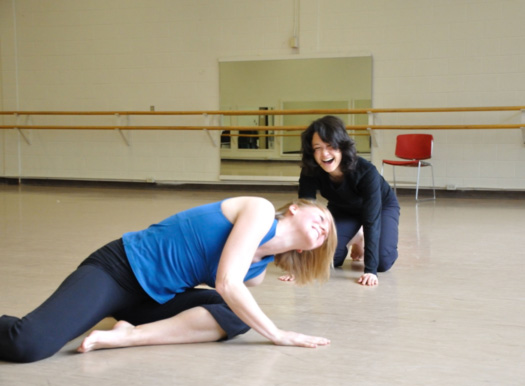
5. The Movements of Failure
Remember that the body is generally hospitable. Skin opens to chance, to harm, to the encounter with resistance. But the body is also xenophobic: its bruises signal a reterritorialization of momentum. Thus, proprioception must be acutely tuned to the common sense or else contact will become collapse.[4] Bones clunk, tendons twist, bodies fall under their own weight. Though a movement may hold a moment in centrifugal tension, its efferent longings may also atomize and send bodies hurtling into space. There is no shame, however, in the fall into singularity. In it one may recognize the pleasure of a different direction.
In another group exercise, we agreed to explore the possibility of non-relation, consciously working to move without connection or response to any of the others in the room. The challenge was to attend to one’s own impulses, regardless of whatever else was happening in the room. Despite the focus on self-attentiveness—which may have felt liberating for the more solitary-minded among us or dangerously directionless for those used to following the kinesthetic drives of others—it seemed to us that a group rhythm still emerged, one framed instead by the basic imperative of safety (for, luckily, there were no accidents), the architecture of the room, the play of light and ambient sound, or even this philosophical negativity that is its own form of disavowal. The play of non-relation struck us as a reminder of how the structure of conventional academic discussion often risks manifesting as hierarchical presentation, despite our best intentions at meaningful dialogue: each person at the table propounding their own ideas, impervious to the comments and silences of others, but all inspired nonetheless by a curiosity that moves them.
Overall, our group play allowed us to speak in other ways to each other, to think of movement in concrete terms, and to consider transposing the trust, spontaneity and attentiveness to others required by the work into other spaces where moving and being moved are more politically, emotionally and intellectually necessary.
Works Cited
Braidotti, Rosi. Transpositions: On Nomadic Ethics. Cambridge: Polity, 2006. Print.
Diprose, Rosalyn. Corporeal Generosity: On Giving with Nietzsche, Merleau-Ponty, and Levinas. New York: SUNY, 2002. Print.
Notes
[1]The improvisational exercises were drawn from a long tradition of theatre games developed by 20th century practitioners such as Jerzy Grotowski, Augusto Boal, and others, as well as the kind of attentive, relational play demanded by a compositional practice such as the “viewpoints” used by Anne Bogart of SITI Company. We both brought our recent training with Canadian practitioners like Susan Liska (Toronto) and The Only Animal (Vancouver) to bear on the structure and choice of games for the Banff sessions.
[2]This flocking exercise, along with the 3:2 movement/stillness exercise described below, were adapted from ensemble improvisation workshops led by Toronto dance teacher, Susan Liska.
[3]Feminist philosopher Rosi Braidotti describes the possibility of a new transformative ethics based on the transdisciplinary practice of transposition and the notion of a non-unitary, transitory form of subjectivity in her book Transpositions: On Nomadic Ethics (2006). To imagine the subject as in transit, simultaneously transforming and transposing difference, is to imagine the play of forces that might move us into a more ethical, sustainable direction. We imagine our forms of movement as one kind of tracing this process of change.
[4]Rosalyn Diprose frames this phenomenological orientation as generosity, which she defines “as a prereflective corporeal openness to otherness” (2002: 5). Generosity is material, intersubjective, and intercorporeal. Diprose’s intention in Corporeal Generosity: On Giving with Nietzsche, Merleau-Ponty, and Levinas (2002) is to explore the connection between such corporeal generosity and the desire for social justice by rethinking generosity beyond economic models of self-other relations or notions of a radical ethics. Thus, the openness of the body functions as the condition for our affective play of proximity and distance to the other, for the social production of differences, for the formation and transformation of communities, and for the promise of “a passionate politics that aims for a justice that is not yet here” (14).
